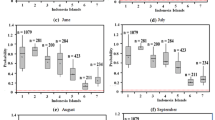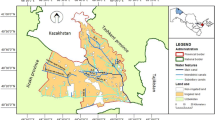Abstract
The present study identifies water-stressed areas based on linkages between NOAH model-based soil moisture and seasonal paddy rice cultivation in the Dwarakeswar–Gandheswari river basin. Soil moisture provides information about crop water stress distribution. A new analytic hierarchy process (AHP)-based index is proposed for water stress evaluation. The spatially distributed paddy rice cultivation is essential from the water resource management point of view. Temperature vegetation dryness index (TVDI), regional water stress index, standardized water level index, and vegetation health index (VHI) are considered for detecting water-stressed area. Water stress indices, soil moisture, and paddy rice cultivation are considered on a seasonal basis (Boro, Aus, and Aman) for the period 2011–2016. The spatial patterns of TVDI, VHI, and rice cultivation are derived from Landsat 7 Enhanced Thematic Mapper Plus and Landsat 8 Operational Land Imager satellite images. Kendall’s tau is considered for correlation analysis. Sensitivity analysis is performed for the generation of AHP-based new water-stressed zone map. The results show that the downstream portion of the river basin has low water stress compared to the upstream part. Ultimately, the results are validated using 20 field sample points. This analysis will be helpful for the irrigation water management framework.











Similar content being viewed by others
References
Abbas A, Minallh N, Ahmad N, Abid S, Khan M (2016) K-means and ISODATA clustering algorithms for landcover classification using remote sensing. Sindh Univ Res J SURJ (Sci Ser) 48(2):315–318
Andrade FR, da Silva GN, Guimarães KC, Barreto HBF, de Souza KRD, Guilherme LRG, dos Reis AR (2018) Selenium protects rice plants from water deficit stress. Ecotoxicol Environ Saf 164:562–570
Annual Flood Report (2014) Irrigation and waterways directorate. Government of West Bengal, Kolkata
Bhuiyan C, Singh RP, Kogan FN (2006) Monitoring drought dynamics in the Aravalli region (India) using different indices based on ground and remote sensing data. Int J Appl Earth Obs Geoinf 8(4):289–302
Cao X, Zhong C, Zhu C, Zhu L, Zhang J, Wu L, Jin Q (2018) Ammonium uptake and metabolism alleviate PEG-induced water stress in rice seedlings. Plant Physiol Biochem 132:128–137
Danvi A, Jütten T, Giertz S, Zwart SJ, Diekkrüger B (2016) A spatially explicit approach to assess the suitability for rice cultivation in an inland valley in central Benin. Agric Water Manag 177:95–106
Dhar A, Sahoo S, Dey S, Sahoo M (2014) Evaluation of recharge and groundwater dynamics of a shallow alluvial in central Ganga basin, Kanpur (India). Nat Resour Res 23(4):409–422
Dong J, Xiao X, Menarguez MA, Zhang G, Qin Y, Thau D, Moore B (2016) Mapping paddy rice planting area in northeastern Asia with Landsat 8 images, phenology-based algorithm and Google Earth Engine. Remote Sens Environ 185:142–154
EIA-EMP-Report (2007) Irrigation and waterways directorate. Government of West Bengal, Kolkata
Gao Z, Gao W, Chang NB (2011) Integrating temperature vegetation dryness index (TVDI) and regional water stress index (RWSI) for drought assessment with the aid of LANDSAT TM/ETM+ images. Int J Appl Earth Obs Geoinf 13(3):495–503
Holzman ME, Rivas R, Piccolo MC (2014) Estimating soil moisture and the relationship with crop yield using surface temperature and vegetation index. Int J Appl Earth Obs Geoinf 28:181–192
Ihuoma SO, Madramootoo CA (2019) Crop reflectance indices for mapping water stress in greenhouse grown bell pepper. Agric Water Manag 219:49–58
Karnieli A, Bayasgalan M, Bayarjargal Y, Agam N, Khudulmur S, Tucker CJ (2006) Comments on the use of the vegetation health index over Mongolia. Int J Remote Sens 27(10):2017–2024
Krishna G, Sahoo RN, Singh P, Bajpai V, Patra H, Kumar S, Sahoo PM (2019) Comparison of various modelling approaches for water deficit stress monitoring in rice crop through hyperspectral remote sensing. Agric Water Manag 213:231–244
Landrum C, Castrignanó A, Zourarakis D, Mueller T (2016) Assessing the time stability of soil moisture patterns using statistical and geostatistical approaches. Agric Water Manag 177:118–127
Li Y, Li Y, Yuan X, Zhang L, Sha S (2018) Evaluation of model-based soil moisture drought monitoring over three key regions in China. J Appl Meteorol Climatol 57(9):1989–2004
Liu Y, Liu Y, Wang W (2019) Inter-comparison of satellite-retrieved and global land data assimilation system-simulated soil moisture datasets for global drought analysis. Remote Sens Environ 220:1–18
Mandal U, Sahoo S, Munusamy SB, Dhar A, Panda SN, Kar A, Mishra PK (2016) Delineation of groundwater potential zones of coastal groundwater basin using multi-criteria decision making technique. Water Resour Manag 30(12):4293–4310
Mao Y, Wu Z, He H, Lu G, Xu H, Lin Q (2017) Spatio-temporal analysis of drought in a typical plain region based on the soil moisture anomaly percentage index. Sci Total Environ 576:752–765
Moharana S, Dutta S (2019) Estimation of water stress variability for a rice agriculture system from space-borne hyperion imagery. Agric Water Manag 213:260–269
Nilsalab P, Gheewala SH, Silalertruksa T (2017) Methodology development for including environmental water requirement in the water stress index considering the case of Thailand. J Clean Prod 167:1002–1008
Pal S, Ziaul S (2016) Detection of land use and land cover change and land surface temperature in English Bazar urban centre. Egypt J Remote Sens Sp Sci 20(1):125–145
Peng D, Huete AR, Huang J, Wang F, Sun H (2011) Detection and estimation of mixed paddy rice cropping patterns with MODIS data. Int J Appl Earth Obs Geoinf 13(1):13–23
Pfister S, Bayer P (2014) Monthly water stress: spatially and temporally explicit consumptive water footprint of global crop production. J Clean Prod 73:52–62
Rahimzadeh-Bajgiran P, Omasa K, Shimizu Y (2012) Comparative evaluation of the vegetation dryness index (VDI), the temperature vegetation dryness index (TVDI) and the improved TVDI (iTVDI) for water stress detection in semi-arid regions of Iran. ISPRS J Photogramm Remote Sens 68:1–12
Saaty TL (1990) Multicriteria decision making: the analytic hierarchy process: planning, priority setting. Resour Alloc 2:1–20
Sahoo S, Dhar A, Kar A, Ram P (2017) Grey analytic hierarchy process applied to effectiveness evaluation for groundwater potential zone delineation. Geocarto Int 32(11):1188–1205
Sahoo S, Dhar A, Debsarkar A, Kar A (2018a) Impact of water demand on hydrological regime under climate and LULC change scenarios. Environ Earth Sci 77(9):341
Sahoo S, Sil I, Dhar A, Debsarkar A, Das P, Kar A (2018b) Future scenarios of land-use suitability modeling for agricultural sustainability in a river basin. J Clean Prod 205:313–328
Schmitter P, Zwart SJ, Danvi A, Gbaguidi F (2015) Contributions of lateral flow and groundwater to the spatio-temporal variation of irrigated rice yields and water productivity in a West-African inland valley. Agric Water Manag 152:286–298
Sharma R, Alam MA, Rani A (2012) K-means clustering in spatial data mining using weka interface. Int J Comput Appl 1:26–30
Uche J, Martínez-Gracia A, Círez F, Carmona U (2015) Environmental impact of water supply and water use in a mediterranean water stressed region. J Clean Prod 88:196–204
Younis SMZ, Iqbal J (2015) Estimation of soil moisture using multispectral and FTIR techniques. Egypt J Remote Sens Sp Sci 18(2):151–161
Zhuang Y, Zhang L, Li S, Liu H, Zhai L, Zhou F, Wen W (2019) Effects and potential of water-saving irrigation for rice production in China. Agric Water Manag 217:374–382
Acknowledgements
The authors thank Irrigation and Waterways Directorate, Government of West Bengal, India, for giving necessary support for this research work. The authors also thank Regional Director, Central Ground Water Board (CGWB), for giving necessary data for this research work.
Author information
Authors and Affiliations
Corresponding author
Ethics declarations
Conflict of interest
No conflict of interest.
Electronic supplementary material
Below is the link to the electronic supplementary material.
Rights and permissions
About this article
Cite this article
Sahoo, S., Dhar, A., Debsarkar, A. et al. Identification of water-stressed area based on the interrelationship of soil moisture and seasonal rice cultivation. Paddy Water Environ 18, 193–209 (2020). https://doi.org/10.1007/s10333-019-00774-7
Received:
Revised:
Accepted:
Published:
Issue Date:
DOI: https://doi.org/10.1007/s10333-019-00774-7




